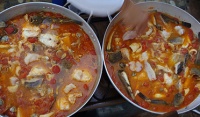
The Brodetto has existed since when fishermen exist.
This popular seafood dish has been the main meal, if not the one, to fishermen for centuries.
Its ancient and popular origin derives from the habit of seafarers to cook on board that part of the fish that could not be allocated to the market, both for its low quality (and low demand), and for its too small size, and finally for 'lack of quantity'.
So the Brodetto takes its origin from a mixture of good though not large fish, simply cooked in olive oil. Gradually, the receipe passed through various and ever more refined changes, gaining a well deserved reputation throughout the national territory and becoming a incontestable prerogative of the Marche Region.
There is no codified receipe for the soup, but there are many variations on this theme. There was and there is, even less frequent, a brodetto on board , made with fish that were available at the moment on board, and a home brodetto that lives on in some families, more rigorous in the use for appropriate fish species.
There is also a restaurant brodetto in which shrimps, cobs, clams or mussels, have been added. In most traditional receipes, these crustaceans are not strictly necessary to use
Fish for brodetto are divided into two groups: those having hard flesh and releasing fluids (Monkfish, bouquet, stargazer, redfish, weefers, red mullet) and those having soft absorbing that broth (or pout cod thornback, dogfish, dogfish with cuttlefish).